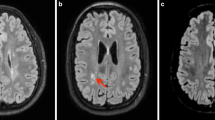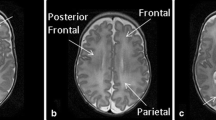Abstract
Children surviving premature birth present with a wide spectrum of motor, sensory and cognitive disabilities, ranging from slight motor deficits, school difficulties and behavioural problems to cerebral palsy and mental retardation. The anatomic and functional substrate of these problems can be investigated using a variety of imaging techniques. Cranial US coupled with colour Doppler is a well-established method for the initial diagnosis of intraventricular haemorrhage, parenchymal haemorrhagic infarct and periventricular leukomalacia. MRI is useful for the follow-up study of brain maturation. Conventional T1- and T2-weighted sequences, magnetization transfer and diffusion tensor imaging coupled with sophisticated tools of tissue segmentation and analysis at a voxel level offer substantial anatomic and functional information on pathological conditions that define the prognosis of preterm infants.










Similar content being viewed by others
References
Fawke J (2007) Neurological outcomes following preterm birth. Semin Fetal Neonatal Med 12:374–382
Volpe JJ (2009) The encephalopathy of prematurity—brain injury and impaired brain development inextricably intertwined. Semin Pediatr Neurol 16:167–178
Veyrac C, Couture A, Saguintaah M et al (2006) Brain ultrasonography in the premature infant. Pediatr Radiol 36:626–635
Argyropoulou MI, Xydis V, Drougia A et al (2003) MRI measurements of the pons and cerebellum in children born preterm; associations with the severity of periventricular leukomalacia and perinatal risk factors. Neuroradiology 45:730–734
Counsell SJ, Rutherford MA, Cowan FM et al (2003) Magnetic resonance imaging of preterm brain injury. Arch Dis Child Fetal Neonatal Ed 88:F269–F274
Xydis V, Astrakas L, Drougia A et al (2006) Myelination process in preterm subjects with periventricular leucomalacia assessed by magnetization transfer ratio. Pediatr Radiol 36:934–939
Xydis V, Astrakas L, Zikou A et al (2006) Magnetization transfer ratio in the brain of preterm subjects: age-related changes during the first 2 years of life. Eur Radiol 16:215–220
Counsell SJ, Shen Y, Boardman JP et al (2006) Axial and radial diffusivity in preterm infants who have diffuse white matter changes on magnetic resonance imaging at term-equivalent age. Pediatrics 117:376–386
Ment LR, Hirtz D, Huppi PS (2009) Imaging biomarkers of outcome in the developing preterm brain. Lancet Neurol 8:1042–1055
Mukherjee P, McKinstry RC (2006) Diffusion tensor imaging and tractography of human brain development. Neuroimaging Clin N Am 16:19–43, vii
Fransson P, Skiold B, Engstrom M et al (2009) Spontaneous brain activity in the newborn brain during natural sleep—an fMRI study in infants born at full term. Pediatr Res 66:301–305
Tzarouchi LC, Astrakas LG, Xydis V et al (2009) Age-related grey matter changes in preterm infants: an MRI study. Neuroimage 47:1148–1153
Papile LA, Burstein J, Burstein R et al (1978) Incidence and evolution of subependymal and intraventricular hemorrhage: a study of infants with birth weights less than 1, 500 gm. J Pediatr 92:529–534
de Vries LS, Roelants-van Rijn AM, Rademaker KJ et al (2001) Unilateral parenchymal haemorrhagic infarction in the preterm infant. Eur J Paediatr Neurol 5:139–149
Vasileiadis GT (2004) Grading intraventricular hemorrhage with no grades. Pediatrics 113:930–931, author reply 930–931
Hill A, Shackelford GD, Volpe JJ (1984) A potential mechanism of pathogenesis for early posthemorrhagic hydrocephalus in the premature newborn. Pediatrics 73:19–21
Taylor GA, Madsen JR (1996) Neonatal hydrocephalus: hemodynamic response to fontanelle compression—correlation with intracranial pressure and need for shunt placement. Radiology 201:685–689
Takashima S, Mito T, Ando Y (1986) Pathogenesis of periventricular white matter hemorrhages in preterm infants. Brain Dev 8:25–30
Rademaker KJ, Groenendaal F, Jansen GH et al (1994) Unilateral haemorrhagic parenchymal lesions in the preterm infant: shape, site and prognosis. Acta Paediatr 83:602–608
Volpe JJ (2001) Neurobiology of periventricular leukomalacia in the premature infant. Pediatr Res 50:553–562
Weiss J, Takizawa B, McGee A et al (2004) Neonatal hypoxia suppresses oligodendrocyte Nogo-A and increases axonal sprouting in a rodent model for human prematurity. Exp Neurol 189:141–149
McConnell SK, Ghosh A, Shatz CJ (1989) Subplate neurons pioneer the first axon pathway from the cerebral cortex. Science 245:978–982
Kanold PO (2004) Transient microcircuits formed by subplate neurons and their role in functional development of thalamocortical connections. Neuroreport 15:2149–2153
Ghosh A, Antonini A, McConnell SK et al (1990) Requirement for subplate neurons in the formation of thalamocortical connections. Nature 347:179–181
Kostovic I, Judas M (2002) Correlation between the sequential ingrowth of afferents and transient patterns of cortical lamination in preterm infants. Anat Rec 267:1–6
Bystron I, Molnar Z, Otellin V et al (2005) Tangential networks of precocious neurons and early axonal outgrowth in the embryonic human forebrain. J Neurosci 25:2781–2792
Letinic K, Zoncu R, Rakic P (2002) Origin of GABAergic neurons in the human neocortex. Nature 417:645–649
Tan SS (2002) Developmental neurobiology: cortical liars. Nature 417:605–606
Inta D, Alfonso J, von Engelhardt J et al (2008) Neurogenesis and widespread forebrain migration of distinct GABAergic neurons from the postnatal subventricular zone. Proc Natl Acad Sci U S A 105:20994–20999
Leijser LM, de Vries LS, Cowan FM (2006) Using cerebral ultrasound effectively in the newborn infant. Early Hum Dev 82:827–835
Tzarouchi LC, Astrakas LG, Zikou A et al (2009) Periventricular leukomalacia in preterm children: assessment of grey and white matter and cerebrospinal fluid changes by MRI. Pediatr Radiol 39:1327–1332
Counsell SJ, Allsop JM, Harrison MC et al (2003) Diffusion-weighted imaging of the brain in preterm infants with focal and diffuse white matter abnormality. Pediatrics 112:1–7
Inder T, Huppi PS, Zientara GP et al (1999) Early detection of periventricular leukomalacia by diffusion-weighted magnetic resonance imaging techniques. J Pediatr 134:631–634
Roelants-van Rijn AM, Groenendaal F, Beek FJ et al (2001) Parenchymal brain injury in the preterm infant: comparison of cranial ultrasound, MRI and neurodevelopmental outcome. Neuropediatrics 32:80–89
Engelbrecht V, Rassek M, Preiss S et al (1998) Age-dependent changes in magnetization transfer contrast of white matter in the pediatric brain. AJNR 19:1923–1929
Thomas B, Eyssen M, Peeters R et al (2005) Quantitative diffusion tensor imaging in cerebral palsy due to periventricular white matter injury. Brain 128:2562–2577
Pierpaoli C, Barnett A, Pajevic S et al (2001) Water diffusion changes in Wallerian degeneration and their dependence on white matter architecture. Neuroimage 13:1174–1185
Nagy Z, Westerberg H, Skare S et al (2003) Preterm children have disturbances of white matter at 11 years of age as shown by diffusion tensor imaging. Pediatr Res 54:672–679
Peterson BS, Vohr B, Staib LH et al (2000) Regional brain volume abnormalities and long-term cognitive outcome in preterm infants. JAMA 284:1939–1947
Lin Y, Okumura A, Hayakawa F et al (2001) Quantitative evaluation of thalami and basal ganglia in infants with periventricular leukomalacia. Dev Med Child Neurol 43:481–485
Ricci D, Anker S, Cowan F et al (2006) Thalamic atrophy in infants with PVL and cerebral visual impairment. Early Hum Dev 82:591–595
Author information
Authors and Affiliations
Corresponding author
Rights and permissions
About this article
Cite this article
Argyropoulou, M.I. Brain lesions in preterm infants: initial diagnosis and follow-up. Pediatr Radiol 40, 811–818 (2010). https://doi.org/10.1007/s00247-010-1585-y
Received:
Accepted:
Published:
Issue Date:
DOI: https://doi.org/10.1007/s00247-010-1585-y




